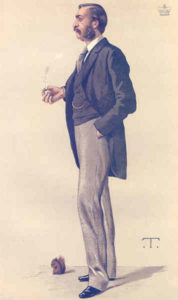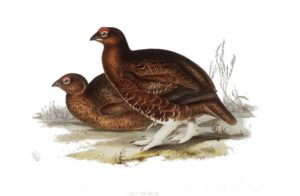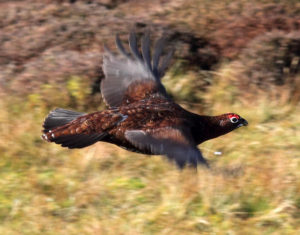Lord Walsingham was known as a crack shot. He had to have been to shoot more than one thousand game birds on a single day. His total—1,070—remains a world record, and it is unlikely that it will ever be exceeded.
Thomas de Grey, also known as the 6th Lord Walsingham, lived in Blubberhouse Moor, a small village in the Yorkshire region of northeastern England. Living from 1861 to 1919, he was a well-respected member of the British gentry, serving in a variety of civic roles and renowned as a cricketer. He was also an accomplished naturalist, especially a student of Micro-Lepidoptera, the taxa of tiny moths and butterflies. He amassed a significant collection over his life, donating more than 250,000 specimens to the Natural History Museum in London. He wrote books and papers about insects and birds from various parts of the world.

But, it seems, he loved shooting birds above anything else. The moorlands of his home are the ideal habitat for the Red Grouse (Lagopus lagopus scoticus), which eats heather and shelters in the evergreen plants all year long. Hunting these birds became popular in the mid-1800s, when an expanding railway system allowed hunters easier access to northern moorlands and shotguns became breech-loading, allowing easier loading and re-loading (note the similarity to the increased harvest of American bison in the Great Plains of the U.S.). Hunting is usually conducted by beaters who walk through the moors (on “drives”), flushing birds towards shooters (called “guns”) stationed in blinds.

That was the technique Lord Walsingham used on August 30, 1888, when he established his record. The first drive of the day occurred at 5:12 AM, the last at 6:45 PM. He hunted with a series of shotguns, being constantly re-loaded and handed to him by assistants. In all, Walsingham’s beaters completed 20 drives, and he shot 1,057 of the birds they drove his way. He completed his day by shooting 13 birds as he walked home, to reach the total of 1,070 Red Grouse shot by one person on one day. According to one report, he shot one bird every 13 seconds over the 12+ hours of his hunt.
He was a crack shot, of course, but he was also after a very accommodating prey. Red Grouse were obviously very abundant at the time and remain so today. Current densities just before the opening of the hunting season are about 1 bird for every 4 acres; densities in 1888 were probably much higher, especially on Walsingham’s estate. The habit of grouse to remain hidden and motionless until a beater is almost on top of them means the quarry never scatters as hunting continues.

Red Grouse were a favorite of Lord Walsingham, and most British would agree. Their meat quality is famous for taste and nutritional value (the species is known as the “King of Gamebirds”). The species (or perhaps a sub-species of the Willow Ptarmigan) lives only in England, Scotland, Wales and Ireland. It is the official gamebird of Scotland. Hunting in Great Britain begins traditionally on August 12, known as “Glorious Twelfth,” and continues until late November or early December. And the Red Grouse is a big money-maker for the economy of northern England and Scotland. Hunting them employs about 2500 people and generates about $200 million dollars annually.
One difference between U.S. and British hunting laws is that wild birds can still be sold in regular markets. Lord Walsingham defended the large harvest of birds on his property in 1888, saying, “out of 2,000 grouse bagged … on my 2,200 acres, 500 were given away to friends, and 1500 were sent to market.” Bagging a meal of Red Grouse in a fancy restaurant on the Glorious Twelfth is still on many English bucket lists.
Red Grouse depend on intact moors for their continued existence. The upland moor habitat has been shrinking over the last century, due to conversion to pastureland and climate change. Moorlands are rarer today than tropical rainforest, and 75% of all remaining area (about 3million acres) is in the British Isles. Consequently, moorland conservation is the principal means for ensuring sustainable populations (and harvests) of Red Grouse.
Let’s hope that Lord Walsingham’s record is never challenged again. The records we should be seeking today are not how many birds we can harvest, but how much habitat we can preserve.
References:
British Association for Shooting & Conservation. Grouse shooting and management in the United Kingdom: its value and role in the provision of ecosystem services. Available at: https://basc.org.uk/wp-content/uploads/downloads/2015/03/Research-White-Paper-Grouse-shooting-and-management.pdf. Accessed July 12, 2018.
Game & Wildlife Conservation Trust. Red Grouse. Available at: https://www.gwct.org.uk/research/species/birds/red-grouse/. Accessed July 12, 2018.
Godfrey, Rupert. Lord Walsingham’s Grouse. Fieldsports Magazine. Available at: https://www.fieldsportsmagazine.com/Shooting-Grouse/lord-walsingham-s-grouse.html. Accessed July 12, 2018.
The Telegraph. 2017. Grouse shooting: 12 facts about The Glorious 12th. The Telegraph, 7 August 2017. Available at: https://www.telegraph.co.uk/news/0/grouse-shooting-12-facts-about-the-glorious-12th/. Accessed July 12, 2018.

